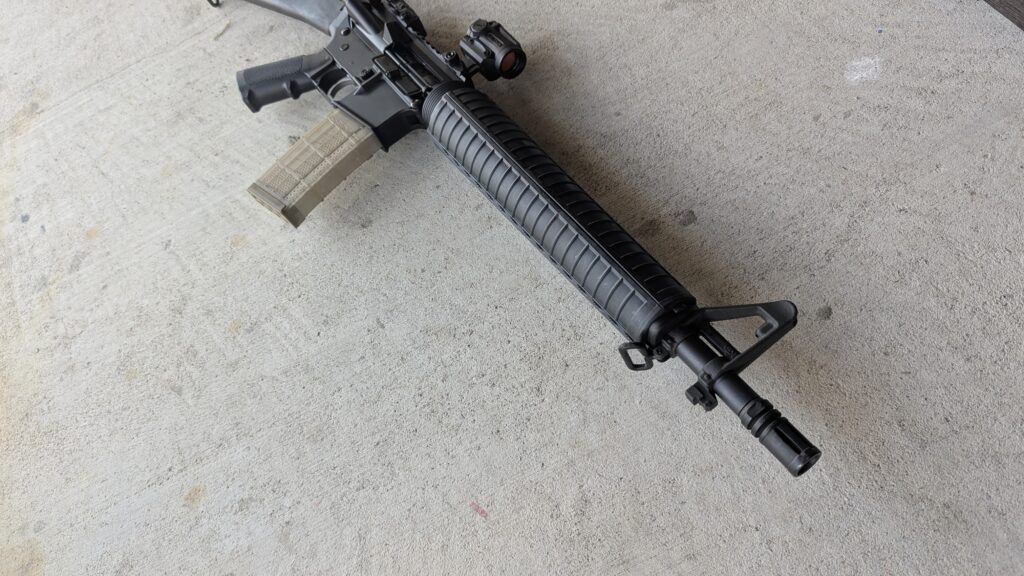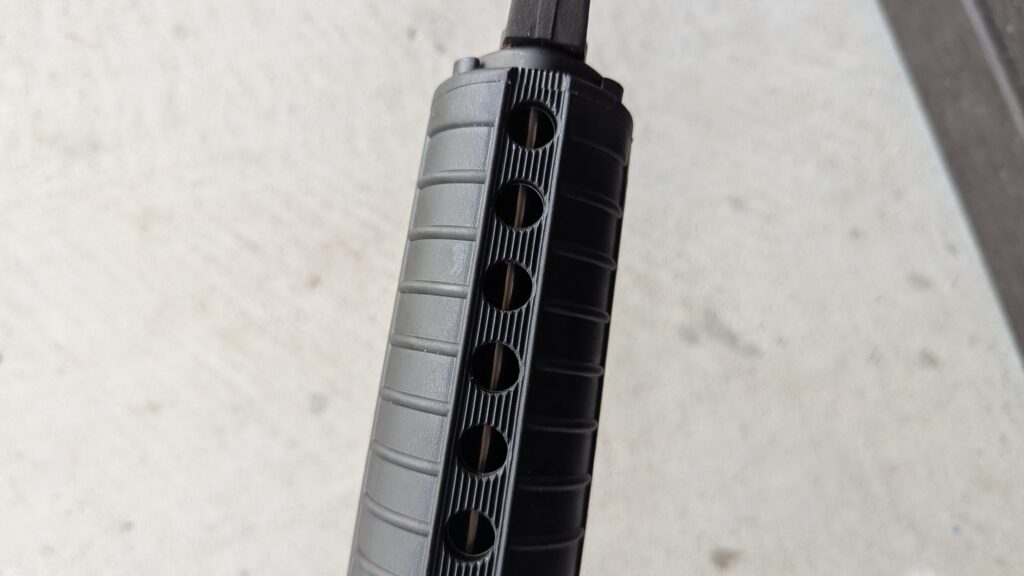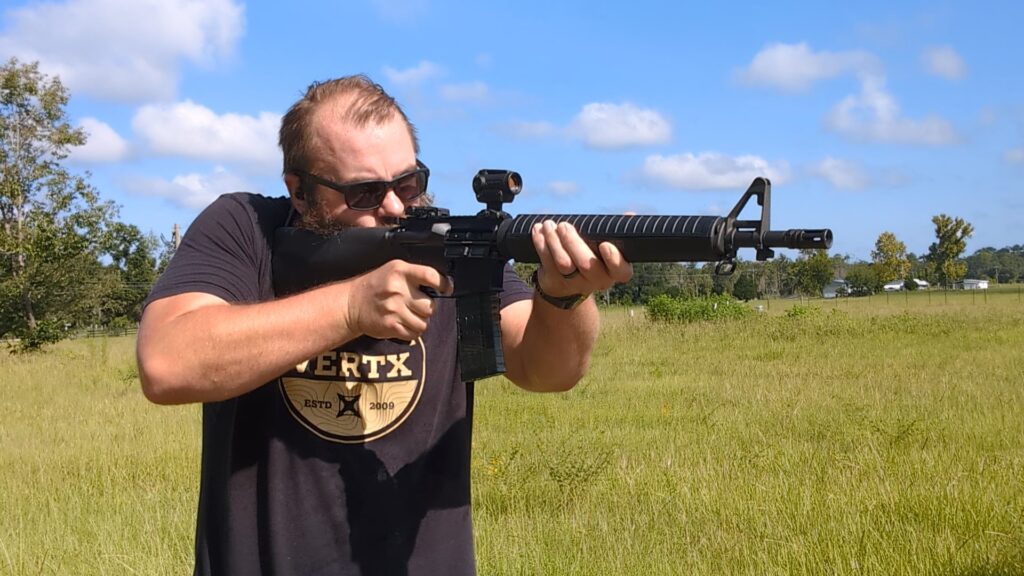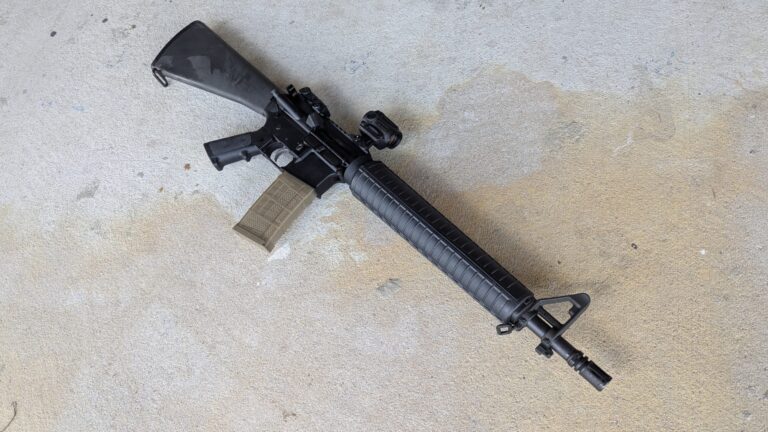My AR experience started in the Marine Corps. My first rifle was an M16A2 and eventually an M16A4. I had an M4 for about the blink of an eye, and I remember my first impression of the carbine as that it was much rougher shooting. I’ve since learned an in-depth difference between AR gas systems. As a fan of rifle-length gas systems and short barrels, the Dissipator idea seemed so cool.
The idea of Dissipator dates back to Colt and Vietnam. Troops wanted a shorter rifle for jungle combat. Colt took an M-16 and cut the barrel at the gas block to about 15 inches, slapped a muzzle device on, and called it the Colt 605. Supposedly, a few of these guns went to Vietnam, but they didn’t perform well. Decades later, people figured out you can make a Dissipator more reliable by enlarging the gas port.
Disspator Origins
The Dissipator’s namesake came from Bushmaster, who advertised their handguards as Dissipators because they dissipated heat. Somehow, that name got attached to any rifle that used a rifle-length gas system with a 16-inch barrel. These days, I’d argue it could apply to any rifle that uses a gas system that’s longer than it should be for barrel length. An 11.5-inch barrel with a mid-length gas system could arguably be a Dissipator.
The benefit of a longer gas system is less recoil and a smoother shooting gun. When you combine a rifle-length gas system with a 16-inch barrel, you arguably get the best of both worlds. A short barrel with less recoil? Who could hate that?

The Dissipator market is flooded with fake Dissys. Fake Dissys use a mid-length gas system and a fake front sight gas block. Real Dissys are rare in the modern era. In fact, only Del-Ton and Anderson produced real Dissipators, and now both Anderson and Del-Ton are no more. As Anderson announced their closure, I flew to the internet to secure a Dissipator. I always wanted one, and my opportunities seemed to be drying up.
Anderson’s Dissipator – The Last of the Poverty Ponies
Anderson has always been a budget brand, and the complete Dissipator cost me 600 dollars. That’s not a terrible price, but it seems like the price went up a hair since Anderson announced their closure. I could swear these were $499 flat at one point. Anderson bills these as a retro rifle, which is odd.

I guess anything with a front sight base and fixed stock can be considered retro these days. The upper is an A4 flat-top design. The stock is an A2 type with that glorious A2 length of pull and the Skittle compartment. The front sight base is a traditional FSB, and Anderson even tossed in a rear Magpul sight, which is a nice touch.
If you’re an iron sight fan, the Dissipator offers you a rifle-length sight radius, which makes accurate shooting easier. However, I tossed on a Holosun ARO for my shooting and testing. The front handguards are those classic A2 design, that’s plastic with an integrated metal heat shield. The A2 pistol grip is also a classic, but I always hated that little hump.

The Anderson Dissipator is all standard AR. Standard magazine release, standard safety, standard charging handle, it’s just all Mil-Spec style controls and ergonomics. Other than the rifle-length gas system and carbine-length barrel, the Dissipator is as plain as it gets.
The Dissipator At The Range
As a Dissy fanboy, I know this is not as plug-and-play as other AR-15s. Even with the larger gas port, the shorter dwell time can cause issues. Your best bet is to stick with M855, M193, and full-power .223 Remington loads. You’re likely to have better luck with 5.56 in the reliability department.
Since I’m reviewing the gun, I brought a mix of ammo. This includes a selection of my remaining steel-cased Tula and Bear ammo, M193, M855, 55-grain .223 PMC, and some AAC 77-grain OTM ammo. I got the performance I expected.

I had a handful of failures to load and cycle the steel-cased ammo. Steel case ammo doesn’t expand in the chamber, so this reduces pressure, which, when mixed with the dwell time of the Dissipator, doesn’t play well. The malfunctions were 99% failures to cycle completely. I had one malfunction that required me to manually eject the gun to free a spent cartridge.
With brass-cased ammo, there wasn’t a single failure. It ran flawlessly, even with the PMC .223. The Dissipator is a brass-cased beast, and that’s honestly to be expected with a Dissipator.
Shooting Straight
Since weare discussing ammunition, we can also discuss accuracy. The best accuracy was achieved with the 77 Grain AAC ammo. Using a red dot, a rest comprised of a backpack and a barrel, I was able to achieve 3-inch groups with five shots fired per group.

The Dissipator isn’t a precision rifle by any means, but for a $600 rifle, I don’t expect much. It’s not equipped with a free-floating barrel or anything that falls in the realm of precision AR. With basic M855, I saw 4 MOA groups at best. It’s good enough for most uses, but not stellar by any means.
The best thing about the Dissipator comes down to smooth shooting. That rifle-length gas system does a great job of reducing recoil and making the gun handle smoothly. It’s the smoothest 5.56 carbine I’ve ever handled. The control leads to excellent results up close and afar.

Less recoil and a smoother recoil impulse result in less dot movement at longer ranges. It jumps a hair and settles right back where I want it. This makes it a little easier to get quick shots on target at longer ranges.
Up close, that lack of recoil does a good job. From a low ready, I can shoot a Bill Drill in 1.65 seconds. That’s a lot of 5.56 fired quickly and accurately at close range. The little dot just buzzes a bit between shots. There is a major difference between the recoil and muzzle rise from the Dissipator and a standard carbine.
It’s About the Feel
The Dissipator weighs a mere six and a half pounds. It’s light and handy. The simple polymer furniture does wonders for weight and not much else. The handguards get hot quickly and become a bit less fun to shoot with. I’ll give them credit for having that smell. If you’ve ever shot a bit with these old-school polymer handguards, you know that when they heat up, they get a very distinct smell.
The stock is too long, and the length of pull is a bit silly for modern shooting. It works fine, but it’s not a great stock by any means. I plan to swap the stock and handguard for some Magpul MOE furniture. The fixed stock and two-piece M-LOK handguard will be a welcome upgrade to the Dissipator.

Ergonomically, the controls and design are fine. It’s basic AR controls. I might swap the charging handle and pistol grip, too. I don’t need a ton of fancy stuff, but I like a larger charging handle, and I want to ditch the hump on the A2 grip.
The Anderson Dissipator isn’t a bad gun; it’s just a $600 gun. It’s not all that accurate, and the furniture feels dated, but the benefit of the Dissaptor remains. The Dissipator is incredibly smooth shooting with low recoil. Keep away from the steel-cased ammo, and you won’t run into any reliability issues. It’s a great working rifle and a fun plinker, but probably not my first choice for a precision gun.
Specifications
- Barrel Length – 16 inches
- Overall Length – 35.5 inches
- Weight – 6.5 pounds
- Caliber – 5.56/.223 Rem
Star Ratings (out of Five Stars)
Accuracy – ***
A 3 MOA rifle gets three stars. It’s fine, not impressive, and for most shooters, 3 MOA is good enough. Very few people need anything that’s 1 MOA, and even fewer can shoot 1 MOA in the first place.
Reliability – ***(and a half)
With brass-cased ammo, there aren’t any reliability issues, but steel-cased ammo slows it down and chokes it. I imagine any light-loaded .223 isn’t going to run well with the Dissipator.
Ergonomics – ***
Again, it’s fine. Fine gets three stars. The stock length is probably the biggest downside. The cheap handguards aren’t great, and while AR ergonomics are fine, the gun doesn’t excel.
Overall – *** (and a half)
It’s tough to judge this gun. I like it personally because I think Dissipators are cool. I like rifle-length gas systems, and I like the smooth shooting design of the Dissipator. However, since people are reading this and making purchasing decisions, I have to put my bias aside. It’s a fine rifle, but it’s not stellar by any means, and 3.5 stars seems fair.
Read the full article here



